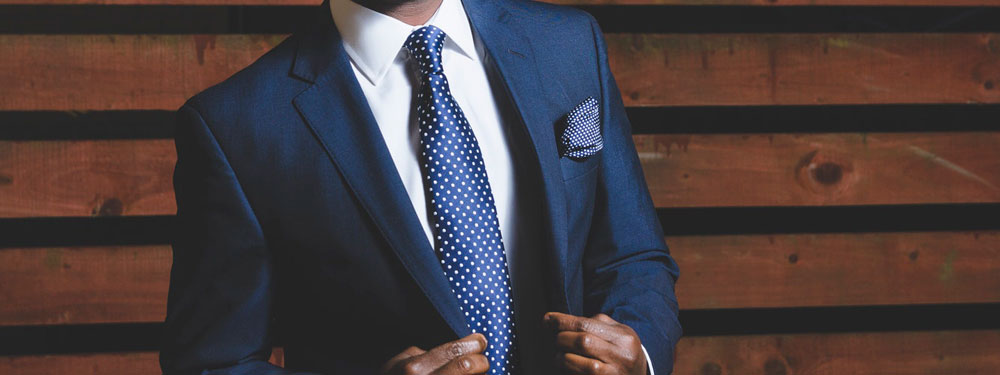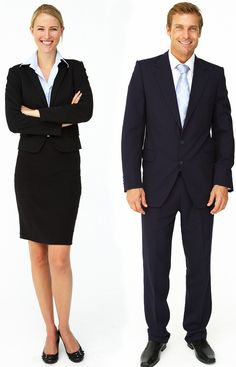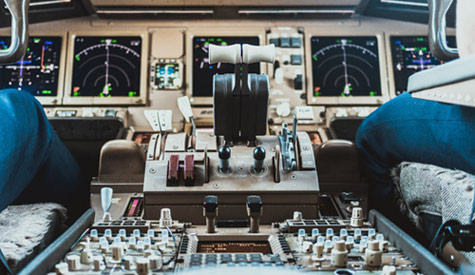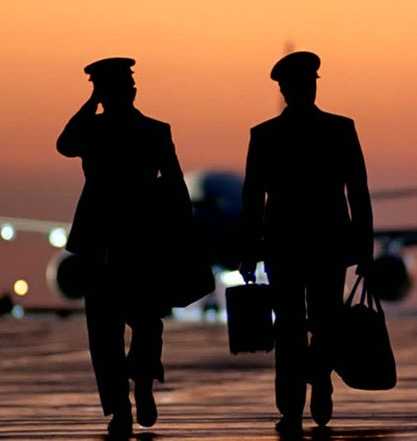How to Ace the Pilot Interview

First impressions only happen once and are hard to change once set. A good first impression will get your interviewers on board with you being a good candidate.
Each person you interface with at a potential employer will form an opinion of you based on your looks, body language, mannerisms, and demeanor. The interviewers and recruiters will form their judgment of you in comparison to corporate
culture and values.
Make it a priority to get interviewers to visualize you as a pilot at their company. This can be a difficult balancing act though as you want the interviewer to focus on your qualifications and not be aware of your appearance.
Pilot Interview Attire
Dress for the position you want. Aviation companies are historically conservative. For most pilot interviews a suit is expected.
Appearance Standards for Men

- Tailored single-breasted suit of good quality. Dark blue or dark gray is the best color.
- Long-sleeved, solid white shirt.
- Tie is mostly solid with a few narrow stripes or subtle pattern.
- Plain-toed lace up shoes in good condition and polished.
- Leather belt the color of shoes. Braided or beaded belts are not appropriate.
- Short hair cut with minimal product at most. Crew cuts or shaved bald are not appropriate.
- No facial hair. Previous facial hair should be shaved off several weeks before interview so skin tones can match.
- Do not wear anything fragrant.
- Little to no jewelry. Bracelets and necklaces are not appropriate.
- Plain leather bag in good condition.
Appearance Standards for Women
- Solid-color skirted suit in navy blue or gray.
- Skirt length just below the knee.
- Pant suits are acceptable for the simulator evaluation.
- Long-sleeve solid white blouse. No ruffles, elaborate colors, or fancy buttons.
- Leather low-heel shoes. Plain dark blue or black with closed toe.
- Skin-colored hose with no pattern.
- If long longer than shoulder length wear it pulled back.
- Natural looking makeup.
- Short and well manicured nails. No bright colors or designs.
- One slim attache or briefcase. Use this bag as your purse.
- Little to no jewelry. One ring per hand, one earring per ear, one necklace. Jewelry should be conservative.
- Don’t wear perfume.
Interview Body Language
Handshake
Always start an interview with shaking hands. You are more likely to be remembered and your interviewer(s) will be more open. A firm handshake will convey confidence, though don’t overdo it use a death grip. A two-handed handshake is not appropriate when in the first meeting with a person.
Not only should you master an appropriate handshake but you should also practice responding graciously to people inexperienced with shaking hands.
Sit Up Straight
Sit as if there was as string tied from the top of your head to the ceiling. Sitting straight shows confidence, intelligence, and credibility. Interviewers will perceive lounging back in your chair as lack of interest in the position. And they will see slouching forward as lacking confidence.
Maintain Appropriate Eye Contact

Maintaining good eye contact is a sign that you are trustworthy. Look interviewers in the eye when shaking hands and maintain regular eye contact. Make a point of not being overly persistent with eye contact. Constant eye contact can be perceived as an attempt to intimidate.
Do Not Cross Your Arms or Legs
Crossing your legs or arms makes you appear guarded or defensive.
Lean In Sometimes
Leaning in occasionally shows your interview you are engaged and interested. Do not lean too far an invade your interviewer’s personal space. Most people’s personal space extends about 20 inches.
Figure Out Where Your Hands Go
Find a place for your hands. They do not belong in your pockets or waving around wildly. Subdued hand gestures supporting what you’re saying is appropriate. If you’re looking for something to do with your hands, try pressing your fingertips of your hands together to form a steeple. Do not fidget.
Nod
Nodding shows you’re understanding, agreeability, and interest in the conversation. But as with most things, moderation is key.
Smile
A smile can create a more positive environment. Make sure to avoid a resting angry face. Set up a reminder such as putting your ring or watch on the opposite hand. Each time you notice your reminder you will know to smile.
Acknowledge Each Person
If there is more than one interviewer make sure to briefly address each person by looking at them. When a question is asked, spend more of your attention addressing the person asking the question.
Mirror Your Interviewer
Your default position should be to sit up straight but aligning your body position to what your interviewer is doing shows admiration and agreement. Don’t go to far though if the interviewer is slouching or leaning back excessively.
Be Graceful
When invited to sit, ease into your chair. Don’t plop yourself down.
Interview Etiquette
Greet Interviewers by Last Name
Initially greet your interviewers as Ms, Mrs, or Mr. When you refer to someone by their last name you are saying to them ‘I respect you and you are important. If an interviewer invites you to use their first name then do so.
Verify Your Cell Phone is Off
When you are in your pilot interview there is nothing more important than that interview. You do not need a distraction. Your phone being in vibrate is still a distraction and others can usually hear a cell phone vibrate. Turn your cell phone off before entering the interview.
Let the Interviewers Take Lead
Let the interviewer(s) run the show. Sometimes when an interviewer is laid back or soft spoken you might have an urge to run the pace of the discussion. Don’t do this!
If there are periods of silence, sit and wait patiently. Don’t try to fill the silence. At all points, work on being concise in your answers and avoid talking too much.
Don’t Step on Someone Else When They Are Speaking

Let your interviewer(s) finish their question or statement, pause for 1 to 2 seconds, and then respond to their question or add to their statement.
Pursue the Job Even if You Don’t Want it or the Interview is Not Going Well
Even if you don’t want to be there or just want to be done with an interview be a professional and finish what you started to the best of your ability. Keeping your best foot forward gives you options later should the employer offer
you a job.
Make a point not to prejudge a job position or circumstances. Wait until you have a more complete picture before forming an opinion about a person or company.
Arrive Early But No Sooner Than 15 Minutes
Never be late to an interview. But getting there too early can be annoying to interviewers.
Your Interview is Not Over As Long the Employer Can See or Hear You
Whenever you are on premises of an employer assume that they can hear and see you. Act professional, courteous, and kind at all times. Be aware of your body language and posture whenever an employer can see you.
Assume that each person you interact with will make a report on you that will factor into the hiring decision. Even when approaching or leaving in the parking lot assume that you are being watched.
Promptly Send a Thank You Note
Send a thank you note after your job interview. The purpose of this note is to keep your name in front of hiring personal. Make sure to use the note as a thank you, don’t rehash your interview or attempt to sell yourself anymore.
Retain business cards of people interviewing you if they are offered and use the information on those to address your thank you notes. A thank you email is ok, but a printed thank you letter will have more impact.
Answering Interview Questions
Common pilot interview questions are readily available. You need to review these questions and practice answering them. Be thorough in researching the employer ahead of the interview. Know about their company operations, culture ,values, and current affairs effecting the company.
Tips for Answering Pilot Interview Questions:
- Answer questions in an organized and controlled format. Think of each answer as having a beginning, middle, and closing.
- Most interview questions are designed to be open-ended. A yes or no answer is not appropriate for these questions.
- Answers should be concise. They should rarely be longer than 1 to 2 minutes.
- Don’t rush your answer. Take a brief moment to compose your thoughts.
- Provide examples when they are related to the answer.
- Ask for clarification if you are not certain what the interviewer is asking.
- Directly answer questions. Do not beat around the bush.
- Stay focused on your professional skills and abilities. Don’t elaborate on your personal life unless asked.
- Tailor answers to the employer to emphasize your fit with their culture and values.
Greg started his professional pilot journey in 2002 after graduating from Embry Riddle. Since that time he has accumulated over 8,000 hours working as a pilot. Greg’s professional experience includes flight instructing, animal tracking, backcountry flying, forest firefighting, passenger charter, part 135 cargo, flying for a regional airline, a national low cost airline, a legacy airline, and also working as a manager in charge of Part 135 and Part 121 training programs.



